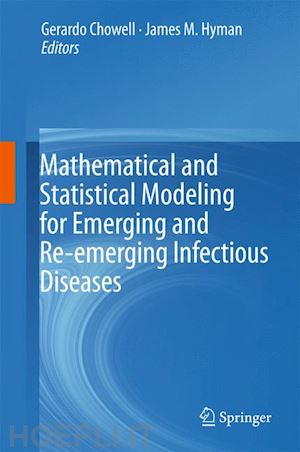
Questo prodotto usufruisce delle SPEDIZIONI GRATIS
selezionando l'opzione Corriere Veloce in fase di ordine.
Pagabile anche con Carta della cultura giovani e del merito, 18App Bonus Cultura e Carta del Docente
The contributions by epidemic modeling experts describe how mathematical models and statistical forecasting are created to capture the most important aspects of an emerging epidemic.Readers will discover a broad range of approaches to address questions, such as
This book will be of interest to researchers in the field of mathematical epidemiology, as well as public health workers.
Preface
1 A Reality of Its Own
3 Modeling the Impact of Behavior Change on the Spread of Ebola
3 A model for coupled outbreaks contained by behavior change
4 Real-time assessment of the international spreading risk associated with the 2014 West African Ebola Outbreak
5 Modeling the case of early detection of Ebola virus disease
6 Modeling ring vaccination strategies to control Ebola virus disease epidemics
7 Estimation of the number of sickbeds during Ebola epidemics using optimal control theory
8 Inverse problems and Ebola virus disease using an age of infection model
9 Assessing the Efficiency of Movement
10 Restriction as a Control Strategy of Ebola
11 Patch models of EVD transmission dynamics
12 From bee species aggregation to models of disease avoidance: The \emph{Ben-Hur} effect}
13 Designing Public Health Policies to Mitigate the Adverse Consequences of Rural-Urban Migration via Meta-Population Modeling
14 Age of Infection Epidemic Models
15 Optimal Control of Vaccination in an Age-Structured Cholera Model
16 A Multi-risk Model for Understanding the Spread of Chlamydia
17 The 1997 Measles Outbreak in Metropolitan São Paulo, Brazil: Strategic Implications of Increasing Urbanization
18 Methods to determine the end of an infectious disease epidemic: A short review
19 Statistical considerations in infectious disease randomized controlled trials
20 Epidemic models with and without mortality: when does it matter?
21 Capturing Household Transmission in Compartmental Models of Infectious Disease
22 Bistable endemic states in a Susceptible-Infectious-Susceptible model with behavior-dependent Vaccination
Index
Gerardo Chowell is an associate professor and a Second Century Initiative Scholar (2CI) in the School of Public Health at Georgia State University in Atlanta. His research program includes the development and application of quantitative approaches for understanding the transmission dynamics and control of infectious diseases including influenza, Ebola, and dengue fever. His work has appeared in high-impact journals including The New England Journal of Medicine, PLOS Medicine, and BMC Medicine, and has been cited by major media outlets including the Washington Post and TIME magazine.
James (Mac) Hyman has developed and analyzed mathematical models for the transmission of HIV/AIDs, influenza, malaria, dengue fever, chikungunya, and infections. His current focus is to identify approaches where these models can help public health workers be more effective in mitigating the impact of emerging diseases. He was a research scientist at Los Alamos National Laboratory for over thirty years, is a past president of the Society for Industrial and Applied Mathematics (SIAM), and now holds the Phillips Distinguished Chair in Mathematics at Tulane University.










Il sito utilizza cookie ed altri strumenti di tracciamento che raccolgono informazioni dal dispositivo dell’utente. Oltre ai cookie tecnici ed analitici aggregati, strettamente necessari per il funzionamento di questo sito web, previo consenso dell’utente possono essere installati cookie di profilazione e marketing e cookie dei social media. Cliccando su “Accetto tutti i cookie” saranno attivate tutte le categorie di cookie. Per accettare solo deterninate categorie di cookie, cliccare invece su “Impostazioni cookie”. Chiudendo il banner o continuando a navigare saranno installati solo cookie tecnici. Per maggiori dettagli, consultare la Cookie Policy.